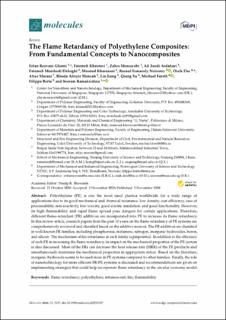| dc.contributor.author | Rezvani Ghomi, Erfan | |
| dc.contributor.author | Khosravi, Fatemeh | |
| dc.contributor.author | Mossayebi, Zahra | |
| dc.contributor.author | Saedi Ardahaei, Ali | |
| dc.contributor.author | Morshedi Dehaghi, Fatemeh | |
| dc.contributor.author | Khorasani, Masoud | |
| dc.contributor.author | Neisiany, Rasoul Esmaeely | |
| dc.contributor.author | Das, Oisik | |
| dc.contributor.author | Marani, Atiye | |
| dc.contributor.author | Mensah, Rhoda Afriyie | |
| dc.contributor.author | Jiang, Lin | |
| dc.contributor.author | Xu, Qiang | |
| dc.contributor.author | Försth, Michael | |
| dc.contributor.author | Berto, Filippo | |
| dc.contributor.author | Ramakrishna, Seeram | |
| dc.date.accessioned | 2022-11-29T16:29:20Z | |
| dc.date.available | 2022-11-29T16:29:20Z | |
| dc.date.created | 2021-03-02T13:43:22Z | |
| dc.date.issued | 2020 | |
| dc.identifier.citation | Molecules. 2020, 25:5157 (21), 1-28. | en_US |
| dc.identifier.issn | 1420-3049 | |
| dc.identifier.uri | https://hdl.handle.net/11250/3034834 | |
| dc.description.abstract | Polyethylene (PE) is one the most used plastics worldwide for a wide range of applications due to its good mechanical and chemical resistance, low density, cost efficiency, ease of processability, non-reactivity, low toxicity, good electric insulation, and good functionality. However, its high flammability and rapid flame spread pose dangers for certain applications. Therefore, different flame-retardant (FR) additives are incorporated into PE to increase its flame retardancy. In this review article, research papers from the past 10 years on the flame retardancy of PE systems are comprehensively reviewed and classified based on the additive sources. The FR additives are classified in well-known FR families, including phosphorous, melamine, nitrogen, inorganic hydroxides, boron, and silicon. The mechanism of fire retardance in each family is pinpointed. In addition to the efficiency of each FR in increasing the flame retardancy, its impact on the mechanical properties of the PE system is also discussed. Most of the FRs can decrease the heat release rate (HRR) of the PE products and simultaneously maintains the mechanical properties in appropriate ratios. Based on the literature, inorganic hydroxide seems to be used more in PE systems compared to other families. Finally, the role of nanotechnology for more efficient FR-PE systems is discussed and recommendations are given on implementing strategies that could help incorporate flame retardancy in the circular economy model. | en_US |
| dc.language.iso | eng | en_US |
| dc.publisher | MDPI | en_US |
| dc.rights | Navngivelse 4.0 Internasjonal | * |
| dc.rights.uri | http://creativecommons.org/licenses/by/4.0/deed.no | * |
| dc.title | The Flame Retardancy of Polyethylene Composites: From Fundamental Concepts to Nanocomposites | en_US |
| dc.title.alternative | The Flame Retardancy of Polyethylene Composites: From Fundamental Concepts to Nanocomposites | en_US |
| dc.type | Peer reviewed | en_US |
| dc.type | Journal article | en_US |
| dc.description.version | publishedVersion | en_US |
| dc.source.pagenumber | 1-28 | en_US |
| dc.source.volume | 25:5157 | en_US |
| dc.source.journal | Molecules | en_US |
| dc.source.issue | 21 | en_US |
| dc.identifier.doi | 10.3390/molecules25215157 | |
| dc.identifier.cristin | 1894908 | |
| cristin.ispublished | true | |
| cristin.fulltext | original | |
| cristin.qualitycode | 1 | |

